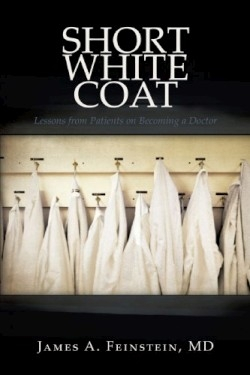Short White Coat
Lessons from Patients on Becoming a Doctor
After two years of “hitting the books,” James Feinstein enters the clinical or hands-on portion of his medical training and comes face to face with patients. His memoir, Short White Coat, named after the third-year medical student uniform, describes Jamie’s transformation from bumbling student to doctor-in-training. “The rough, starched collar of my short white coat chafed at my neck,” Feinstein writes. “I could feel the crunch of the impeccably white fabric as I leaned against the counter. My deep pockets overflowed with medical instruments, cards with different lists of symptoms and therapies, and even a mini textbook. Because of the weight of the pockets, I felt like I had a yoke around my neck.”
The author is obviously comfortable with words and knows how to tell a story, but halfway through the book, readers realize that the author may have but one story to tell. The vignettes have a formulaic feel with a similar outcome. While the details of each case are inviting and interesting (Who doesn’t love an insider’s perspective?), it soon becomes obvious that each story teaches medical students one of two lessons: to give himself time to acclimate to a new setting, or not to judge too harshly or quickly.
Beginning with internal medicine, Jamie works in different departments throughout the year, rotating through obstetrics and gynecology, pediatrics, psychiatry, surgery, and emergency medicine. He seems to roll through each experience, picking up bits and pieces, but never stopping long enough to capture the true essence of any particular scene. The young student frequently jogs through a nearby park where he points out familiar homeless faces installed on three park benches. But as with the patients in this book, we only see them while on the run—a brief impersonal glimpse, not enough to bring them into clear focus.
The inside look at medical situations, the forthright honesty of the author’s writing style, and the main character’s tendency toward self-deprecation draws readers into the young medical student’s struggles. Readers will cheer for his efforts to grasp, process, and internalize everything thrown at him in this gonzo-style medical training. Unfortunately, there is a sense of disorientation, not just for the medical student, but also for the reader. Without reference to time or place, outside influences, or current events, the facts—though they ring true—lose their authority in this vacuous setting.
This well-written memoir begs for more depth, more detail, more introspection, and a more varied presentation of the experiences. Still, anyone who has ever encountered the medical profession, whether wearing the short white coat or the paper gown, will find this a light, entertaining, and touching read.
Disclosure: This article is not an endorsement, but a review. The publisher of this book provided free copies of the book and paid a small fee to have their book reviewed by a professional reviewer. Foreword Reviews and Clarion Reviews make no guarantee that the publisher will receive a positive review. Foreword Magazine, Inc. is disclosing this in accordance with the Federal Trade Commission’s 16 CFR, Part 255.

